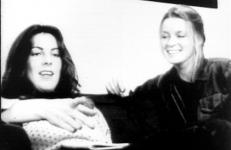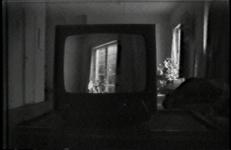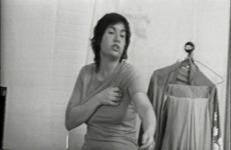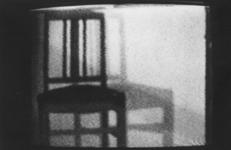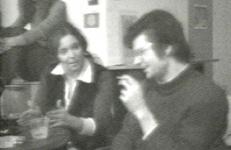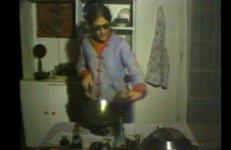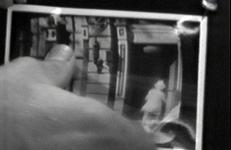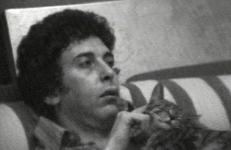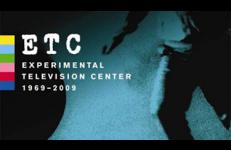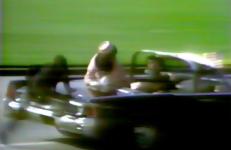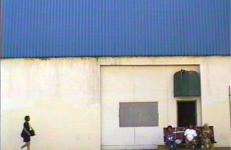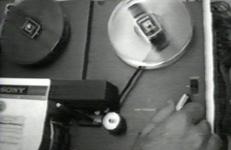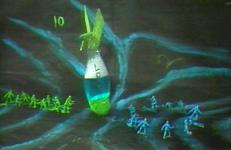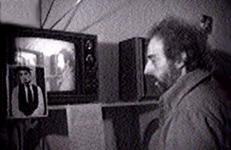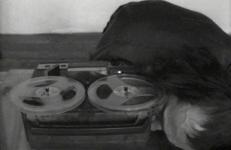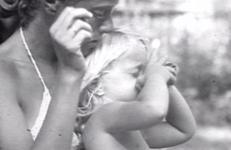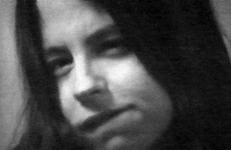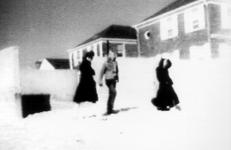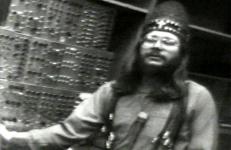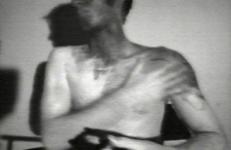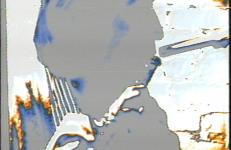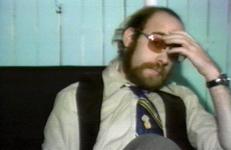Done To (alternately titled It Is, Done To) consists of simple still-frames accompanied by a complex, incongrous soundtrack, or silence. There are instances where image and sound coalesce; however, the majority of the images are overwhelmed by the at-times symphonic, at-times cacaphonous soundtrack, displacing the normal film viewing experience. The standard film format of going from frame to frame — and then and then and then — is what this film is concerned with.
Video History
Campus investigates the metaphoric overlap between properties of the video camera and processes of human perception, an area of great interest to many early videomakers.
A reverse striptease, non-stop comedic monologue about shopping for clothes, while eating corn nuts. Dressing Up was inspired by the artist’s mother’s penchant for bargain hunting. Mogul produced Dressing Up as a student in the feminist art program at the California Institute of the Arts in 1973.
A collection of early conceptually oriented videos which were produced in Tokyo in the early 1970s using words along with images, except for the first two flicker-effect pieces: A Chair (1970) and Blinking (1970).
Time Tunnel (1971) is an attempt at time travel in a very conceptual sense.
Man and Woman (1971) shows full body images of a naked man and woman shot from above without movement. They are shown alone as well as together, one over (or under) the other, symbolizing words at the same time as their positions.
In this rare and humorous record of the art dialogue of the late 1960s, Holt and "guest" Robert Smithson assume opposing artistic viewpoints: the uptight, intellectual New Yorker versus the laid-back Californian. Their play-acting lays bare the cliches and stereotypes of a "bi-coastal" art world. While Holt stresses analytic, systematic thinking, Smithson represents the polar opposite, privileging visceral experience and instinct, saying, "I never read books; I just go out and look at the clouds." and "Why don't you stop thinking and start feeling?"
Rosler uses the format of a cooking demonstration (as in Semiotics of the Kitchen) to address cultural transaction--the meeting of Eastern and Western cultures. Reading directly from a West Bend Electric Wok instruction booklet, Rosler wryly comments upon the Oriental mystique conjured by the West Bend manufacturers, a mystique evoked and then "improved" upon through Western technology--i.e. non-stick surfaces and electric power.
Baldessari has Ed Henderson examine obscure movie stills and attempt to reconstruct the films’ narratives. By removing the image from its ordinary context—in this instance the chronological flow of film time—the process of interpretation itself and the contextual meaning carried by images is examined. During these interpretative exercises, Ed Henderson urges the viewer to question where the meaning of an image lies: within the image itself or within the spectators’ reading of the image.
This title was in the original Castelli-Sonnabend video art collection.
Benglis uses the video format as a metaphor for other types of limiting conditions or limited realities. "The constant motion of Benglis's hand-held camera (scanning her studio and two television sets) calls attention to the limits of the camera's field of vision: the walls of the studio are the ultimate 'enclosure' of the camera's eye. The open window and the sound of children (from the street) seem to suggest release; yet the confines of the studio are never truly broken."
ETC: Experimental Television Center 1969-2009 is a five-DVD box set presenting the electronic media work of over one hundred artists who participated in the Center’s Residency Program during a 40-year period. The collection offers a look at the evolution of the unique artist-designed sound and image tools that are the hallmark of the Center’s studio, and provides a view into the constantly changing artistic processes and practices that have shaped the work over the years.
Irreverent yet poignant, The Eternal Frame is a re-enactment of the assassination of John F. Kennedy as seen in the famous Zapruder film. This home movie was immediately confiscated by the FBI, yet found its way into the visual subconscious of the nation. The Eternal Frame concentrates on this event as a crucial site of fascination and repression in the American mindset.
"The intent of this work was to examine and demystify the notion of the presidency, particularly Kennedy, as image archetype...."
— Doug Hall, 1984
Irreverent yet poignant, The Eternal Frame is a re-enactment of the assassination of John F. Kennedy as seen in the famous Zapruder film. This home movie was immediately confiscated by the FBI, yet found its way into the visual subconscious of the nation. The Eternal Frame concentrates on this event as a crucial site of fascination and repression in the American mindset.
"The intent of this work was to examine and demystify the notion of the presidency, particularly Kennedy, as image archetype...."
— Doug Hall, 1984
Irreverent yet poignant, The Eternal Frame is a re-enactment of the assassination of John F. Kennedy as seen in the famous Zapruder film. This home movie was immediately confiscated by the FBI, yet found its way into the visual subconscious of the nation. The Eternal Frame concentrates on this event as a crucial site of fascination and repression in the American mindset.
"The intent of this work was to examine and demystify the notion of the presidency, particularly Kennedy, as image archetype...."
— Doug Hall, 1984
Filmed in Susan Mogul’s Los Angeles multi-ethnic working class neighborhood, Highland Park, Everyday Echo Street: A Summer Diary, is an insider’s view of how home and neighborhood are constructed in everyday relations. Composed of conversational and anecdotal portraits of neighbors and merchants, Susan ruminates about the past and the present, as she looks out her apartment window. Struggling to arrive at a new definition of “home,” she ponders loss, middle age, and living alone.
This video documents the history of U.S. community television and public access TV, using rare video clips from across the nation. Combining unique archival footage from the early days of cable, rediscovered footage from the 1/2" portapak era, and interviews with access pioneers, Everyone's Channel provides an illuminating overview of the people, ideas, and technological developments that helped make cable access a reality, and stresses the continuing need to see it as a vital necessity and right.
In EVOL (love spelled backwards), the audience is voyeur, peering into the delirious and erotic dreams of a young man (Oursler). We drift with him through anecdotes that poke fun at the disparity between the culturally accepted stereotypes of sex and love we are taught as children and the realities we discover in adult life.
In 1972, Robert Morris and Lynda Benglis agreed to exchange videos in order to develop a dialogue between each other’s work. Morris’s video, Exchange, is a part of that process—a response to Benglis’s Mumble. At the beginning of the piece, Morris comments on the nature of the collaboration, their interaction, and what they represent to each other. Morris’s speculations about work, travel, and relationships are juxtaposed with frozen images of race cars, Benglis herself, images from Benglis's video, and Manet’s Olympia.
Acconci listens to his own recorded monologue of sexually intimate secrets and repeatedly tries to obscure these secrets by shouting over the tape, demonstrating the paradoxical situation of the artist confounded by two desires: to reveal oneself for the sake of pleasing the audience, and the conflicting desire to protect one’s own ego. As viewers, we are intrigued and tantalized by the confession we never hear.
Over a montage of family photographs, Freed’s narration questions the consistency of memory and self over time, with Freed displaying a quizzical and sometimes hostile relation to her past. In a manner that recalls philosopher Roland Barthes’s poetic unraveling of photography—in particular photography’s power to bind memory and desire within a still image—Freed attempts to uncover the “stranger” that is her childhood self and discover how her past has shaped her present.
Feathers: An Introduction is a self-portrait centered on the story of Latham's grandmother’s comforter which, old and worn, scatters feathers everywhere. Displaying an arresting stage presence, Latham addresses the viewer as a potential friend or lover, speaking in a soft-spoken near-whisper, and gingerly touching and kissing the camera lens and monitor. Then, almost mocking the video’s intimacy, Latham gives us close-ups of herself chewing a sandwich and shaving her armpits, heightening the sense that she has been playing cat and mouse with the viewer all along.
As two heavily made-up women take turns directing each other and submitting to each other's kisses and caresses, it becomes increasingly obvious that the camera is their main point of focus. Read against feminist film theory of the "male gaze", the action becomes a highly charged statement of the sexual politics of viewing and role-playing; and, as such, is a crucial text in the development of early feminist video.
Using the structure of a feature film as its basic format, A First Quarter adopts the principles of nouvelle vague cinema. Simultaneous realities, altered flashbacks, and plays on time and space, are all components of the form and content of this film. Because it was originally shot on video, then kinescoped to 16mm film, A First Quarter has acquired a softened, poetic look. The dialogue derives entirely from the creation of the work as it is spoken and read, built, enacted, written, and painted by the players.
In 1973, Dan Sandin designed and built a comprehensive video instrument for artists, the Image Processor (IP), a modular, patch programmable, analog computer optimized for the manipulation of gray level information of multiple video inputs. Sandin decided that the best distribution strategy for his instrument "was to give away the plans for the IP and encourage artists to build their own copies.
Presenting his bare torso to the camera, Nauman meticulously applies, and removes, layers of white and black pigment, to his face, arms, and chest. Beyond the link to body art, and the idea of treating the human body as artistic subject matter and material, Nauman enacts a process of self-transformation—a masque applied and removed—as the tape ends where it began.
This title was in the original Castelli-Sonnabend video art collection.
"Newly hand-built digital video A to D and D to A with ALU bit flipping. Controlled by an ELF II computer. The image brightness changes also controlled analog synthesizer parameters of the live flute playing. I sat in the camera image zone and played along with the programmed staccato picture and sound shifts. David Jones, digital video design."
– Peer Bode
For Example: Decorated is a talk show featuring art world personalities Britte Le Va, Peter Gordon, and James Sarkis. The show begins with Le Va reciting the credits; then she introduces herself, Soviet style — as in Do You Believe in Water? — by saying her name, then clapping. The other guests follow, and as the three converse about the role of art in life, they build little structures with the Lego blocks that cover the coffee table.




